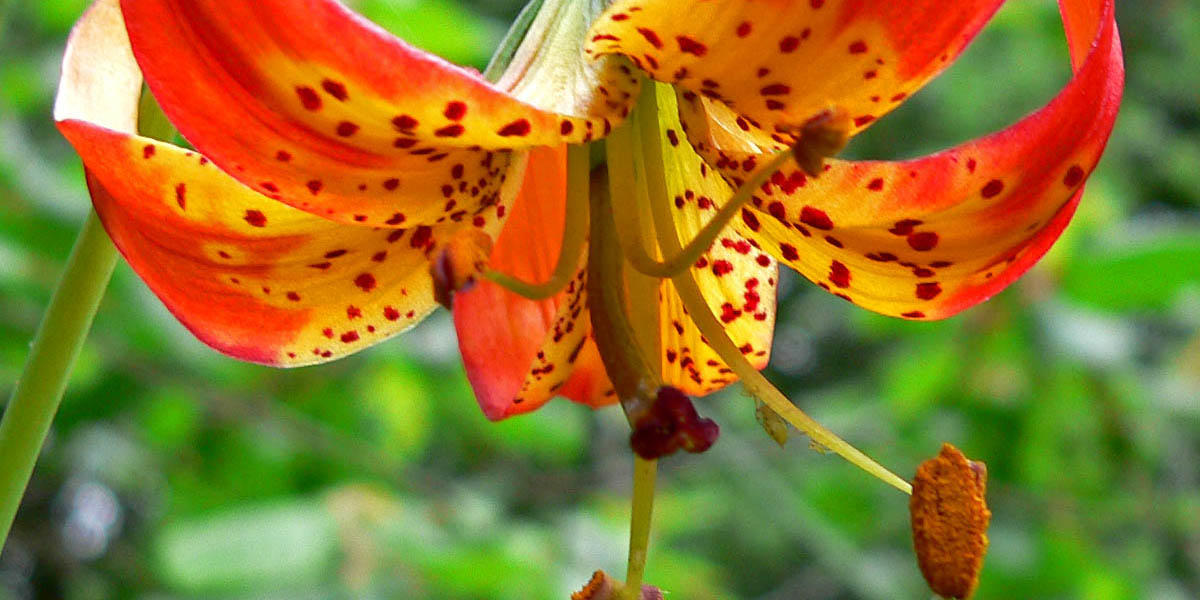
Leopard Lily, scientifically known as Belamcanda chinensis, is a strikingly beautiful flowering plant that belongs to the Iris family. With its vibrant orange and black spotted flowers, it adds a touch of exotic elegance to any garden or landscape. Native to East Asia, Leopard Lily has gained popularity worldwide due to its unique characteristics and mesmerizing blooms.
In this article, we will delve into the world of Leopard Lily and uncover 17 intriguing facts about this fascinating plant. From its historical significance to its medicinal uses, we will explore the various aspects that make Leopard Lily a cherished botanical species. Whether you are an avid gardener or simply have an interest in plants, these facts will provide you with a deeper understanding and appreciation for the beauty and diversity of the natural world. So let’s embark on this journey and discover the wonders of Leopard Lily!
Key Takeaways:
- Leopard Lily is a visually stunning flower with medicinal properties, attracting pollinators and symbolizing beauty and grace. It’s easy to care for and thrives in partial shade, making it a versatile and low-maintenance plant.
- This unique plant is a symbol of strength and resilience in Chinese culture, with a long blooming period and resistance to pests and diseases. It’s a popular cut flower and comes in various color variations, adding elegance to any garden.
The Leopard Lily is a unique and visually stunning flower
The Leopard Lily, also known as Iris domestica, is a striking flower that is native to the forests of China and Japan. Its distinctive leopard-like spots on the petals give it a captivating appearance.
It belongs to the iris family
The Leopard Lily belongs to the iris family and is known for its sword-like leaves and beautiful flowers. It is a perennial plant that blooms during the summer months, adding a touch of elegance to any garden.
The Leopard Lily is a symbol of strength and resilience
In Chinese culture, the Leopard Lily is considered a symbol of strength and resilience. It is believed to bring good fortune and protect against evil spirits. Its vibrant colors are also associated with happiness and joy.
It attracts pollinators
The Leopard Lily is a magnet for pollinators such as bees and butterflies. Its nectar-rich flowers and distinct fragrance attract these beneficial insects, aiding in the pollination process and promoting biodiversity.
The Leopard Lily has medicinal properties
Traditionally, various parts of the Leopard Lily plant have been used in herbal medicine. Its rhizomes and leaves are known for their anti-inflammatory and antipyretic properties, and have been used to treat various ailments.
It is an invasive species in some regions
Due to its ability to spread rapidly, the Leopard Lily has become an invasive species in certain parts of the world. Its aggressive growth can outcompete native plants and disrupt local ecosystems if not properly controlled.
The Leopard Lily is easy to care for
For gardeners looking to add a touch of exotic beauty to their gardens, the Leopard Lily is a perfect choice. It is relatively easy to care for and requires minimal maintenance, making it suitable for both experienced and novice gardeners.
It is a perennial plant
Unlike annual plants that need to be replanted each year, the Leopard Lily is a perennial plant. Once established, it will continue to bloom year after year, bringing its unique beauty to the garden.
It thrives in partial shade
The Leopard Lily prefers to be grown in partial shade, making it an excellent choice for gardens with dappled sunlight or areas that receive moderate shade throughout the day. However, it can also tolerate full sun if provided with adequate moisture.
The Leopard Lily has a long blooming period
When properly cared for, the Leopard Lily can have a long blooming period, extending from late spring to early autumn. This prolonged display of vibrant flowers adds a splash of color to the garden for several months.
It is a low-maintenance plant
The Leopard Lily is relatively low-maintenance, requiring minimal pruning and attention. However, regular watering and well-draining soil are essential to ensure its optimal growth and overall health.
The Leopard Lily is resistant to pests and diseases
One of the many advantages of growing Leopard Lilies is that they are relatively resistant to pests and diseases. This makes them a suitable choice for gardeners who prefer to minimize the use of chemical pesticides.
It can be propagated through division
Leopard Lilies can be easily propagated through division. By carefully separating the rhizomes, new plants can be created and replanted in different areas of the garden, allowing for the expansion of this beautiful species.
The Leopard Lily is a popular cut flower
With its unique and eye-catching appearance, the Leopard Lily is frequently used as a cut flower in floral arrangements. Its long-lasting blooms and striking patterns make it a favorite among florists and flower enthusiasts.
It is a versatile plant
The Leopard Lily can be grown in various settings, including garden beds, containers, and even as a houseplant. Its adaptability and ability to thrive in different environments make it a versatile choice for any green space.
The Leopard Lily is a symbol of beauty and grace
With its graceful form and striking colors, the Leopard Lily has come to symbolize beauty and grace. Its elegant appearance adds elegance and sophistication to any garden or floral arrangement.
It can be found in different color variations
While the Leopard Lily is commonly associated with its yellow flowers and dark spots, it can also be found in various color variations. These include white, pink, and purple, offering a range of options for those looking to incorporate this stunning flower into their landscaping.
These 17 intriguing facts about Leopard Lily highlight its unique beauty, cultural significance, and ease of cultivation. Whether you are an avid gardener or simply appreciate the wonders of nature, the Leopard Lily is truly a fascinating plant to explore and enjoy.
Conclusion
The Leopard Lily is a truly remarkable plant that captivates with its striking appearance and fascinating characteristics. From its vibrant leopard-like spots to its medicinal properties, there is much to learn and appreciate about this unique flower.
Whether you’re a passionate gardener looking to add a touch of exotic beauty to your garden or simply intrigued by the wonders of the natural world, the Leopard Lily is sure to leave a lasting impression. Its ability to thrive in various climates and its role in traditional medicine make it an intriguing plant worthy of exploration.
By understanding the 17 intriguing facts about the Leopard Lily, you have gained valuable insights into its origins, symbolism, and cultural significance. So, the next time you come across this enchanting flower, you’ll have a deeper appreciation for its beauty and significance.
FAQs
1. What is the scientific name of the Leopard Lily?
The scientific name of the Leopard Lily is Belamcanda chinensis.
2. What are the requirements for growing Leopard Lily?
Leopard Lily thrives in well-draining soil and requires full sun to partial shade. It prefers moderate watering and is best suited for USDA hardiness zones 5-10.
3. Do Leopard Lilies attract wildlife?
Yes, Leopard Lilies are known to attract birds, bees, and butterflies with their vibrant colors and nectar-rich flowers.
4. Can Leopard Lilies be grown in containers?
Yes, Leopard Lilies can be grown in containers, provided they have enough space for their rhizomes to spread and are given adequate sunlight and water.
5. Are Leopard Lilies toxic?
Yes, Leopard Lilies are toxic if ingested by humans or animals. It is advisable to keep them out of reach of children and pets.
6. What is the symbolism of Leopard Lilies?
Leopard Lilies symbolize strength, courage, and resilience in many cultures, as well as beauty and adaptability.
7. Can Leopard Lilies be used for medicinal purposes?
Yes, Leopard Lilies have been used in traditional Chinese medicine for their anti-inflammatory, antipyretic, and diuretic properties. However, it is important to consult a professional before using them for medicinal purposes.
8. How do Leopard Lilies reproduce?
Leopard Lilies reproduce through their rhizomes, which can spread and produce new shoots. They can also be propagated by dividing the rhizomes or growing them from seeds.
9. How tall do Leopard Lilies grow?
Leopard Lilies can grow up to 3-4 feet tall, making them an impressive addition to any garden.
10. Are Leopard Lilies drought-tolerant?
Yes, Leopard Lilies have moderate drought tolerance but prefer consistently moist soil for optimal growth and flowering.
Leopard Lilies captivate with their spotted petals and resilient nature, but have you ever wondered about the hidden world of Ledebouria? These unassuming plants hold unbelievable secrets waiting to be discovered. From their fascinating history to their surprising uses, Ledebouria will leave you amazed and eager to learn more.
Was this page helpful?
Our commitment to delivering trustworthy and engaging content is at the heart of what we do. Each fact on our site is contributed by real users like you, bringing a wealth of diverse insights and information. To ensure the highest standards of accuracy and reliability, our dedicated editors meticulously review each submission. This process guarantees that the facts we share are not only fascinating but also credible. Trust in our commitment to quality and authenticity as you explore and learn with us.


